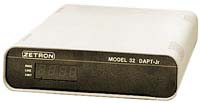|
|
|
|
|
MODEL 32 DAPT-Jr |
| The Model 32 DAPT-Jr is a dial
access paging terminal suitable for automated paging systems in
factories and hospitals or for small RCC/PCP service. With the
capability to encode the signaling formats required by most pagers
and mobiles, this terminal allows for easy automation of existing
manual paging systems. The DAPT-Jr is ideal for small systems of 50 to 250 pagers that can be serviced by one telephone input. (Other models are available for larger systems or systems with special requirements.) Two sizes are available: 100-call and 1000-call. 
The Model 32 is compatible with nearly
any telephone system - central office or PBX. Selector level (DID)
input is most commonly used in
For in-plant PBX applications, the Model 32 can connect either to a
trunk line or a station extension. In a trunk connection (loop
start, ground start, or E&M tie-line), callers dial a short one or
two-digit trunk access code followed by the user�s pager number.
Trunk connections are preferred on PBX�s for easy access to the
paging system. RADIO INTERFACE
Analog capable transmitters are able to
handle conventional tone and voice signaling such as 2-Tone,
5/6-Tone, 2805 Hz, MTS, and DTMF. Digital display pagers such as NEC
D2/D3, POCSAG 512-baud numeric(CCIR RPC #1), and Golay Sequential
Code (GSC) type pagers require true direct-FM FSK digital
transmitters. Even though some transmitters are designed for DCS
(digitally coded squelch), they may not be able to handle the
unbalanced modulation of digital pager data. Be sure to ask the
transmitter manufacturer if the radio is direct FM frequency
modulated (not phase modulated). PROGRAMMING
Nonvolatile memory containing the system
and subscriber programming settings has a built-in battery that
preserves memory during more than 4 years of power loss. If needed,
the memory chip can be moved to another Model 32 for quick
change-over to a backup unit. TALK-BACK PAGING
Talk-back paging allows two-way
communication between telephone (landline) callers and mobile radio
users. Features include landline-to-mobile, mobile-to-landline,
mobile-to-mobile, and mobile-to-pager calling. Talk-back paging is a
standard feature of the 1000-call terminal. To use the talk-back
paging, a duplex radio station which provides COR/CAS signals is
required. Features
|
|
Specifications |
|
GENERAL |
|
| Call Capacity | 100 or 1000 users Morse Code ID |
| Signaling Formats | 2-Tone Motorola, G.E., Reach 5/6-Tone EIA, ZVEI, CCIR, CCITT HSC display and voice POCSAG (NEC D4) 512-baud numeric digital display Golay digital display and voice |
| Morse Code ID | 1024Hz at 20 words/minute Field programmable 15- or 30-minute intervals 0 to 8 characters long D4) 512-baud numeric digital display Golay digital display and voice |
| Power Supply | 120/240V AC +/- 15% or 12V DCeld programmable |
| Operating Temperature | 0 to 65 degrees Celsius |
| Size | 2.25"H x 8"W x 10.5"D |
| Weight | 5 lb. |
| TRANSMITTER | |
| Audio Output | Balanced 600-ohm, 0.2 to 3V pk-pk |
| Control Relays | 1 Amp rating at 26V ACPTT DPDT contacts |
| Digital Data | Unipolar 0 to 7V, adjustable Programmable polarity |
| Digital Mode | 5V TTL logic Polarity jumper selectable |
| CAS/COR input | Voltage level or contact closure0.5V threshold Polarity jumper selectable |
| Connector | Detachable screw terminal strip(s) |
| RECEIVER | |
| Base Station | Half-Duplex |
| Audio Switching | Mobile carrier control |
| Receive Audio Input | Unbalanced Level 0.2V to 20V pk-pk, adjustable |
| Two-Way | Landline-to-pager or
-mobile Mobile-to-landline, pager, or mobile Programmable enable per user Origination enable/disable Connect on key-up Connect on �*� + 3-digit code Disconnect code �#� Programmable limit (0-990 sec) Programmable activity (0-90 sec) Programmable warning time |
| Call Placement | DTMF to 10 pps
conversion DTMF direct dial through Toll restrict 1- or 0- enable/disable Emergency dial with 2 PTT clicks |
|
WISCO International, Inc. -
MIAMI, FL U.S.A. Fax: (954) 370-3997 | E-mail: wiscointl@wiscointl.com |